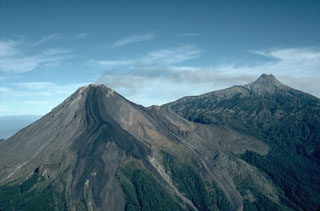Report on Colima (Mexico) — 21 September-27 September 2016
Smithsonian Institution / US Geological Survey
Weekly Volcanic Activity Report, 21 September-27 September 2016
Managing Editor: Sally Sennert.
Please cite this report as:
Global Volcanism Program, 2016. Report on Colima (Mexico) (Sennert, S, ed.). Weekly Volcanic Activity Report, 21 September-27 September 2016. Smithsonian Institution and US Geological Survey.
Colima
Mexico
19.514°N, 103.62°W; summit elev. 3850 m
All times are local (unless otherwise noted)
Based on webcam and satellite images, and information from the Mexico City MWO, the Washington VAAC reported that on 25 September an ash emission from Colima rose to an altitude of 5.2 km (17,000 ft) a.s.l. and drifted NNE.
Geological Summary. The Colima complex is the most prominent volcanic center of the western Mexican Volcanic Belt. It consists of two southward-younging volcanoes, Nevado de Colima (the high point of the complex) on the north and the historically active Volcán de Colima at the south. A group of late-Pleistocene cinder cones is located on the floor of the Colima graben west and east of the complex. Volcán de Colima (also known as Volcán Fuego) is a youthful stratovolcano constructed within a 5-km-wide scarp, breached to the south, that has been the source of large debris avalanches. Major slope failures have occurred repeatedly from both the Nevado and Colima cones, producing thick debris-avalanche deposits on three sides of the complex. Frequent recorded eruptions date back to the 16th century. Occasional major explosive eruptions have destroyed the summit (most recently in 1913) and left a deep, steep-sided crater that was slowly refilled and then overtopped by lava dome growth.

